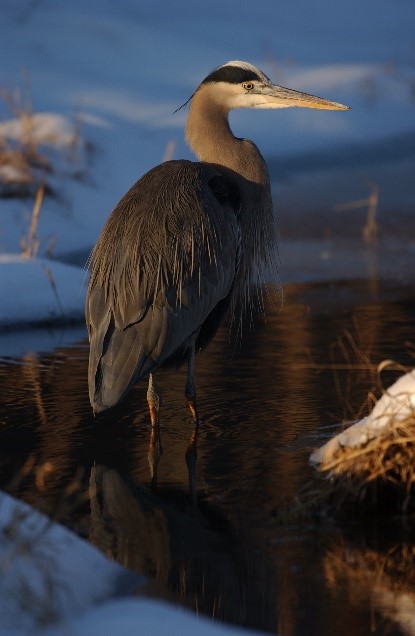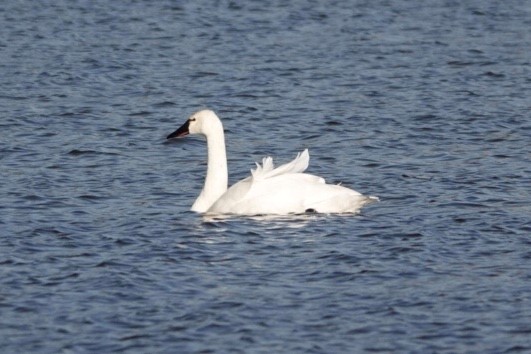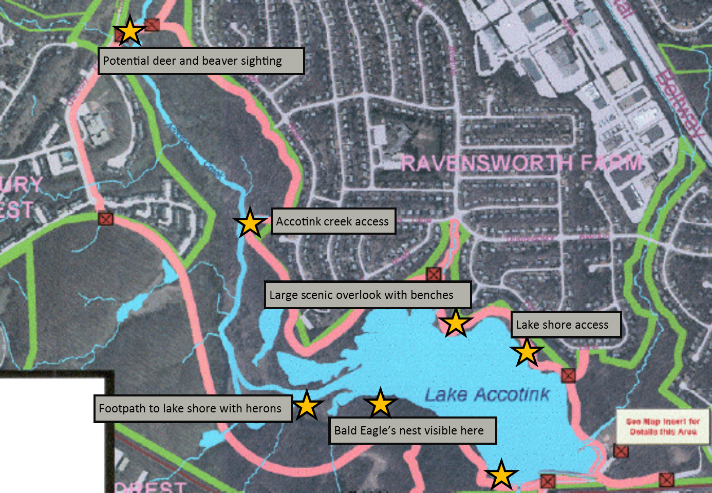Compiled by the Fairfax County Park Authority staff.
Whether you’re a nature photographer or simply an animal lover, winter is a great time to spot wildlife in county parks. With the leaves down, birds and animals are easier to see, and some migrating species only call Fairfax County home during the winter season.
We’ve gathered tips from a few park and recreation sites across the county on what fantastic beasts you might see and where to find them. Green Spring Gardens suggests a circuit hike that may include animal sightings on land, in the air and in the water. Keep reading for some other good wildlife spots.
Green Spring Gardens
 \
\
In the winter, you can spot many types of wildlife at Green Spring Gardens if you walk in a circle from the parking lot, past the Horticulture Center to the children’s gardens behind the building, down the hill into the woods, past the ponds, and back up the hill towards the Historic House.
Walking near the grassy field between the parking lot and the Green Spring Horticulture Center, you may see Canada geese nibbling on the grass. Looking into the sky above the grassy field, you may spot black vultures riding the thermals. Listen for hawks calling, and you may spot a red-tailed hawk soaring above the field looking for a meal. White-throated sparrows love to call from the thick bushes alongside the back of the white gazebo. Chickadees and Carolina wrens can be found in the smaller bushes and trees near the entrance of the Horticulture Center.
Behind the center, you may spot mockingbirds eating holly berries in the Children’s Garden. In the Discovery Garden, listen for screaming blue jays that love to hang out in the cedar trees by the picnic tables. Gray squirrels love to scamper along the fence behind the picnic tables, and you will often see signs of their lunch on the stumps nearby — walnut shells and broken pinecones.
Walking down the Virginia Native Plant Trail into the woods, you may see a white-tailed deer browsing low-lying shrubs. Without leaves on the trees, you can spot squirrels jumping from branch to branch near their dreys high in the oak trees. You may see nuthatches moving headfirst down the trunk of a tulip tree or hairy or downy woodpeckers pecking at the smaller trunks of maple trees. If you are lucky and are there at dawn or dusk, you may catch a glimpse of one of the local foxes.
As you cross the bridge, peer into Turkeycock Run and you often will see Northern cardinals bathing in the stream. After you cross the bridge, close to the wooden boardwalk there are many dead trees, perfect for a variety of woodpeckers looking for an insect. The huge oak logs also are a good place to spot squirrels eating a meal of acorns. As you walk along the boardwalk toward the ponds, look for the occasional red fox in the woods.
At the ponds, you probably will see Canada geese, mallard ducks, and maybe a lone great blue heron. If it’s a warmer winter day, you may spot a turtle on the side of the pond sunning or bluegills swimming near the pond surface. If you see and hear crows cawing, they are probably mad at a Cooper’s hawk, who might have a nest near the sycamore tree. Look in the mud along the pond to see the footprints of raccoons and deer.
As you head up the hill toward the parking lot and the Historic House, there are usually squirrels and blue jays foraging on the ground near the willow oak in front of the house as well as sparrows, chickadees and wrens higher up in the branches of trees closer to the parking lot.
Burke Lake Park

See birds you won’t find at other times of the year at Burke Lake during the winter waterfowl migration. As temperatures dipped, staff spotted ring-necked ducks, bufflehead, hooded mergansers, ruddy ducks and horned grebes. As colder temperatures cause waterways to freeze in the North, park personnel expect to see an increase in the diversity of species as well as an increase in their numbers. As always, Burke Lake Park is also an excellent place to spot and photograph bald eagles.
Frying Pan Farm Park

The meadow behind Frying Pan Farm Park’s indoor arena and the service road behind it, including the adjoining woods, are usually the park’s best wildlife viewing spots. There have been deer, foxes, squirrels, hawks, and other birds in the meadow and surrounding trees. Even some wild turkeys one time.
Look for deer, foxes and turkeys while strolling the nature trail and around the trailer parking lot. You might see deer and foxes around the cornfield and foxes around the run-in shed for the cattle. A hawk has hung around the trees by the small water jump, along with crows. The crows pop up all over.
There are often mallards or Canada geese in the water catchment basin near the northeast edge of the park and cardinals in the trees along the service road between the intersection and Monroe Street. You also can find birds around the Indoor Arena or along the service road from the Visitor Center to the farm. They may not be wild, but don’t miss seeing the farm animals, too.
Hidden Oaks Nature Center
There are a few spots on the trail at Hidden Oaks that can be great for photo ops and wildlife viewing.
At the first red bridge as you go down the Old Oak Trail from the nature center, there’s a creek where families often stop for a look, making it a great spot for a nature-oriented family vacation in winter.. Occasionally, you may spot a deer or turtle down by the creek. Behind the nature center is Nature Playce and a pond which are good for black squirrel sightings and frogs in the spring/summer.
Huntley Meadows
Stroll the Huntley Meadows boardwalk through the park wetlands to spot winter waterfowl such as gadwalls, shovelers, pintails, hooded mergansers, ruddy ducks, canvasbacks and others. In November 2018, staff spotted a merlin and a sora hanging around in the wetland. Capture beautiful landscape views and lighting in winter, too.
Lake Accotink

Lake Accotink has nearly 500 acres of green space, and there are lots of different animals to be seen. There are great locations along the Cross County Trail and the Lake Accotink Trail, which connect to make a four-mile loop trail around the lake and along Accotink Creek.
With the leaves down, hikers along the south side of the lake are likely to see the large bald eagle nest and the breeding pair that live in it. Great blue herons, osprey, and cormorants can be found in and along the edges of the lake. Deer and fox are plentiful throughout the park. Be careful along the main entrance road in the evenings. All along the lake, and especially near the marina, geese and ducks are plentiful. Beaver might be spotted upstream along Accotink Creek. Owls like to hunt in the large open field off of the Heming Road entrance near the McLaren-Sargent Pavilion.
Pinecrest Golf Course

Pinecrest Golf Course is an Audubon International-sanctioned course and has lots of birds that frequent it, such as this mallard duck.
Riverbend Park
The Potomac River attracts a variety of winter waterfowl, and Riverbend Park is a great place for winter birdwatching. Look for flocks of Buffleheads, mergansers, grebes, ring neck ducks, coots, black ducks, and swans. To learn more about what you’re seeing, consider registering for one of the park’s Winter Waterfowl Hikes.
Sully Historic Site
In January, there are wonderful birding opportunities for photographers along the power lines on the eastern edge of Sully Historic Site. There is a small trail there - less than a half-mile - that provides viewing opportunities. Wildlife edge habitat includes bluebirds, cedar waxwings, red-shouldered hawks, Cooper’s hawks, raven, deer, red fox, squirrels, and chipmunks.
*This article originally appeared on the Fairfax County Park Authority blog and was reprinted here with permission. All content and photography was compiled by Park Authority staff.*





